U.S. Department of Transportation
Federal Highway Administration
1200 New Jersey Avenue, SE
Washington, DC 20590
202-366-4000

Best for printing: rsa_summer2013.pdf (982 KB)
To view PDF files, you can use the Acrobat® Reader®.
By Becky Crowe, RSA Program Manager
FHWA Office of Safety
I'm often asked about the benefits of performing a Road Safety Audit (RSA). It's an easy question to answer because there are so many qualitative benefits that agencies recognize when they perform RSAs. It's instinctive that safety improvements arising from an RSA reduce crashes. However, up to this point, we haven't formally quantified the benefits. That has changed with the recent completion of the study, "Road Safety Audits: An Evaluation of RSA Programs and Projects." This study evaluated and measured the safety benefits of specific RSA improvements. Total crash reductions ranged from 10 to 50 percent! Read more about this hot–off–the–press publication in our front–page newsletter article. You will also find several articles on how your agency can implement RSAs in various project phases. I hope you enjoy this issue of the RSA Newsletter and you're having a safe and fun summer!

CALL TO ALL STATES, LOCAL,FEDERAL, AND TRIBAL AGENCIES WITH RSA PROGRAMS Send us information on your RSA Program for inclusion in the National RSA Program Map! Send details to: Becky Crowe, RSA Program Manager, rebecca.crowe@dot.gov and Heather Rigdon, RSA Program Support heather.rigdon.ctr@dot.gov |
Anyone who has ever performed a Road Safety Audit (RSA) or taken RSA training knows there are a variety of benefits in using this unique safety assessment tool. While the benefits of RSAs are substantial, they have been, until now, largely quantitatively unmeasured on a national scale. The new publication, Road Safety Audits: An Evaluation of RSA Programs and Projects, quantifies the benefits of RSAs at both the program and project level.
The RSA programs evaluated for the publication are summarized below along with their key factors for success.
| Agency | Key to RSA Program Success |
|---|---|
| Rhode Island DOT | Focus on high–benefit, low–cost safety and mobility improvements |
| Nevada DOT | Establish RSA champions |
| Kansas DOT | Recurring and well–managed system–wide RSA program |
| Massachusetts DOT | Link RSAs to the Highway Safety Improvement Program |
| Montgomery County, Maryland | Use RSAs to Improve Pedestrian and Bicycle Safety |
| Arizona DOT | Use RSAs for a collaborative and proactive approach to statewide safety |
| Tennessee DOT | RSA Process is Formalized and Uniform |
| Collier County, Florida | Adoption of an RSA policy, including an RSA requirement for design permits |
| South Jersey Transportation Planning Organization | Comprehensive site selection processes |
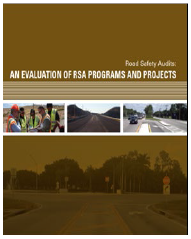 The study also evaluated improvements implemented as a result of five specific RSAs including: Bullhead Parkway in Bullhead City, Arizona; Peavine Road in Cumberland County, Tennessee; Collier Boulevard in Collier County, Florida; Immaculate Road in Collier County Florida; and Ninth Street in Ocean City, New Jersey. These evaluations quantified the safety effectiveness of the suggested improvements in reducing crashes. This consisted of a before–after analysis to measure the benefits derived from crash reduction versus the cost of conducting the RSA and implementing the improvement.
The study also evaluated improvements implemented as a result of five specific RSAs including: Bullhead Parkway in Bullhead City, Arizona; Peavine Road in Cumberland County, Tennessee; Collier Boulevard in Collier County, Florida; Immaculate Road in Collier County Florida; and Ninth Street in Ocean City, New Jersey. These evaluations quantified the safety effectiveness of the suggested improvements in reducing crashes. This consisted of a before–after analysis to measure the benefits derived from crash reduction versus the cost of conducting the RSA and implementing the improvement.
| To download a copy of the publication, please visit http://safety.fhwa.dot.gov/rsa/ |
The five locations exhibited an overall reduction in crashes ranging from 10 percent to 50 percent as a result of the improvements implemented from the RSAs. In addition, the study determined that the benefits of these safety treatments exceeded the total RSA and implementation costs combined. The publication provides detailed information on the statistical evaluation methods used for the evaluation of each RSA as well as a summary of the safety improvements implemented and their benefit/cost ratios.
The RSA programs and RSAs evaluated provide State, local, Federal, and tribal agencies with examples and quantifiable results that can help in implementing RSAs and further their growth and success. Regardless of whether an RSA is performed during the design stage or existing stage, when compared to the cost of automotive crashes, improvements implemented from an RSA are cost effective.
|
RSA Process Suggestion The briefing packet can be especially helpful to RSA team members and road owners who are not familiar with RSAs. Packets might include the following information to help prepare the RSA team.
|

Reflective signal backplates in use at the I–275 Armenia/Howard interchange. Source: FHWA
When RSAs were first introduced in the United States more than 10 yea rs ago, it was hard to imagine how many highway programs could benefit from their use. RSAs continue to expand into new areas with the FHWA Office of Operations leading a project to develop Work Zone RSA (WZRSA) Guidelines & Prompt Lists. To pilot the Guidelines and Prompt Lists, two Work Zone RSAs were performed in Tampa during the week of January 28, 2013. One pilot was performed on a construction project with an active work zone (I–275), and one pilot was performed on a project in the design phase (118th Avenue).
I–275 is an urban freeway/expressway with a speed limit of 65 mph. The project is a complete reconstruction of I–275 from SR 60 (Memorial Highway) to the Hillsborough River. The project will replace 13 bridges, widen 3 bridges, and construct 3 new bridges. It also involves constructing mechanically stabilized earth walls, earthwork fills, drainage, concrete and asphalt pavements, lighting, signing, intelligent transportation systems (ITS), landscaping, and architectural treatments. The active work zone spans several construction seasons, shifts traffic to newly constructed lanes over several segments, and replaces two former right–hand exits with temporary left–hand exits from the freeway.
"This new Work Zone RSA process and guideline are exciting new tools that transportation agencies may use to further enhance the safety and efficiency of all roadway users and workers in and around work zones." – Rudy Umbs, Florida DOT Safety Consultant |
During the WZRSA, the team focused its review on two specific locations at the request of the road owner: the Armenia/Howard interchange and Ashley/Kay interchange. The WZRSA identified several positive project elements, including good delineation through the corridor, the use of signal back plates to increase visibility at night, and repeat exit notification. Some of the RSA recommendations included adding signing to reinforce pavement markings for right turn only lanes on exit ramps, providing special emphasis crosswalks, realigning signal heads, and evaluating signal timing in order to flush ramp traffic upon a green signal.
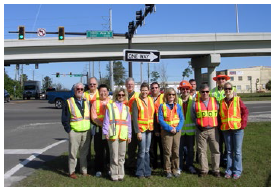 Florida Work Zone RSA Team. Source: FHWA |
A design project on 118th Avenue was selected for the design phase WZRSA. This project was at the 60 percent completion level at the time of the WZRSA. The existing 118th Avenue is a six–lane urban divided highway with major intersections at US 19 and 49th Street. The facility has a posted speed of 45 mph and is classified as a minor arterial. The proposed roadway will be an urban principal arterial consisting of a multi–lane elevated roadway with frontage roads. The design speed is 60 mph for the new mainline express lanes, 40 mph for flyover ramps, and 45 mph for frontage roads and mainline ramps. During the active work zone phase, the design team plans to use several local roads as detour routes. Since the project's design was approximately 60 percent complete at the time of the WZRSA, significant recommendations could be made during the RSA and incorporated into the project as a result.
Recommendations from the WZRSA included considering a complete closure of 118th Avenue to accelerate construction, consolidating detour routes, and restriping detour routes.
WZRSA training has also been developed and was piloted in Tennessee, Arizona, and Nevada. Workshop materials will be finalized by the end of September and available on the National Work Zone Safety Information Clearinghouse website at: www.workzonesafety.org. With the advent of Work Zone RSAs, there is now another opportunity to expand the benefits of RSAs during the pre–construction and construction phases.
| For more information about the RSA evaluation project, or to obtain a copy of the publication, please contact: Jawad Paracha, Work Zone Program Manager, FHWA Office of Operations jawad.paracha@dot.gov |
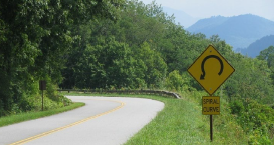 A section of the Blue Ridge Parkway. Source: Dan Nabors, Blue Ridge Parkway Road Safety Assessment Report |
The Federal Highway Administration (FHWA) along with the National Park Service have been working together to build a Road Safety Audit (RSA) Program for the Blue Ridge Parkway (BLRI) to use as a tool to improve roadway safety in the park. The Blue Ridge Parkway's RSA Program was initiated as part of the FHWA pilot program to promote RSAs on Federal and Tribal Lands. BLRI was selected for the pilot program following a review of crash data provided by the southeast regional office (SERO) of the National Park Service (NPS). Data showed that the BLRI in North Carolina has a higher fatality crash rate when compared to the overall state fatality rate data for two–lane rural roadways. BLRI also has a relatively high proportion of severe crashes and has the highest total number of crashes of all parks in the SERO.
The legislated purpose of the Blue Ridge Parkway, as identified 1936, is to link Shenandoah National Park in Virginia with Great Smoky Mountains National Park in North Carolina and Tennessee by way of a recreationally oriented motor road. The roadway provides opportunities to enjoy the scenic beauty of the southern Appalachian Mountains along its 469 mile route. The Blue Ridge Parkway is a limited access roadway, but intersects numerous state, county, and private access roads with at–grade intersections. The Parkway has a maximum speed limit of 45 miles per hour (mph), but is designed for 50 mph.
BLRI Goals in Developing an RSA Program Included:
|
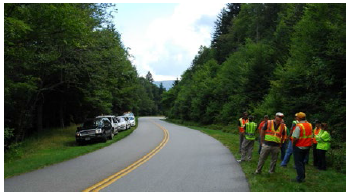 A series of curves near mile marker 427. Source: Dan Nabors, Blue Ridge Parkway Road Safety Assessment Report |
During an early planning meeting in 2012, Parkway staff expressed an interest in using the RSA process to address the significant volume of motorcycle traffic, increasing bus and RV traffic, and recreational and commuter cyclists. Recent statistics show motorcycles accounting for 38 percent of crashes on the Parkway. Bus and RV traffic present another challenge as the original roadway design, including cross section, radius of curves, layout of overlooks, and parking areas, were not designed for this size of vehicle. Additionally, some of the 140 tunnels do not provide sufficient clearance for the height of these vehicles.
RSA training and technical assistance provided to the Blue Ridge Parkway over a 15 month period is helping BLRI implement an RSA program. The program helps BLRI address current needs along with creating a framework and process for identifying and addressing future transportation safety concerns on the Parkway. In conjunction with training on how to conduct an RSA and implement an RSA program, NPS staff at BLRI received technical assistance during their first RSA. This experience provides a foundation for NPS staff to conduct additional RSAs in the future. This pilot RSA Program not only improves safety on the BLRI Parkway, but also lays the foundation for development of similar federal lands programs at parks nationwide.
| For more information, please contact: Larry Hultquist, Project Manager National Park Service Denver Service Center Department of Transportation Larry_hultquist@nps.gov |
Planners, designers, and traffic engineers must anticipate potential driver errors and roadway elements that might contribute to crashes. One way to proactively identify these issues is performing a Road Safety Audit (RSA) during the pre–construction phase. At this stage, RSAs can address significant safety issues and incorporate improvements earlier in the project, which saves lives, time, and money. The RSA suggestions may include major changes such as different route options, cross–section options, intersection/interchange treatments, and pedestrian/bicycle routing and facility options.
"You really want to perform RSAs as early as possible to be able to make changes while the project is in design." – Robert Rocchio, Rhode Island DOT |
Recently, FHWA hosted a webinar on using RSAs during a project's pre–construction phase. Presentations included guidance on how to perform an RSA on a project in design and the benefits of performing this type of RSA. Robert Rocchio, Managing Engineer with Rhode Island DOT, discussed some of the pre–construction RSAs that have been performed in Rhode Island, the recommendations that came out of those RSAs, and changes that occurred to the actual projects. Some of the recommendations resulting from the pre–construction RSAs included: adding additional left turn lanes, restricting left turns from side streets, tightening channelized right turn movements, and incorporating bicycle facilities into the design.
A recording of the webinar will be available on the National Highway Institute (NHI) website. Listen to the webinar to learn how your agency can implement pre–construction phase RSAs. Find the recording at: http://www.nhi.fhwa.dot.gov/about/realsolutions.aspx.
| For more information on Rhode Island's pre–construction RSAs, please contact: Robert Rocchio, Managing Engineering Rhode Island Dept. of Transportation Traffic Design brocchio@dot.ri.gov |
Do You Need Law Enforcement on Your RSA Team?
Law enforcement professionals bring tremendous value to RSAs. They can offer insights to a location that no one else has and provide background on the crashes that occur. Are you performing an RSA and need a police officer on your team? The RSA Peer–to–Peer Program can assist! FHWA has two law enforcement officers available through the Roadway Safety Assistance Program. Master Police Officer (MPO) Brian Walters is the PHOTOSafe program coordinator for the City of Virginia Beach. He holds a Master of Science Degree in Criminal Justice and is one of three officers involved in the City's Road Safety Audit program.
Master Police Officer Paul Anderson has been with Fairfax County Police for over 31 years. Paul's primary role is to work with the Virginia Department of Transportation on requests from members of the Board of Supervisors, citizens, and police officers relating to signal timing to improve vehicle flow and cut–through traffic management. He also analyzes and reviews motor vehicle crash histories at high frequency locations and makes recommendations about their causes as well as opportunities for improvement. He works with traffic engineers on present and future roadway design to minimize the need for enforcement efforts. |
Many times, RSAs start to show systemic issues with the highway system. In MAP–21, The FHWA Office of Safety recently launched a new website dedicated to the systemic approach to safety. The website, A Systemic Approach to Safety – Using Risk to Drive Action, is now available at http://safety.fhwa.dot.gov/systemic.
A Road Safety Audit / Value Analysis Study conducted on SR–16 in California won an Honorable Mention by the AASHTO Value Engineering Technical Committee. The award was granted for the project's innovative use of Value Engineering by merging two processes together and moving the project forward with local support. For more information, visit http://design.transportation.org/Pages/ValueEngineering.aspx.
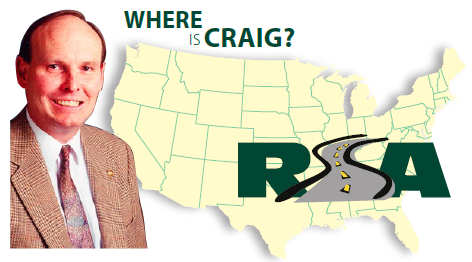 Craig Allred, FHWA Road Safety Audit (RSA) trainer, was in Atlanta the week of July 29 providing RSA training and technical assistance. Following the tragic deaths of a pedestrian this year and a bicyclist in 2012, who were both attempting to cross North Decatur Road, the Atlanta Bicycle Coalition and Bike Emory teamed together to host an RSA training workshop. Following the workshop, an RSA was performed on North Decatur Road to determine opportunities for improvements that would increase safety for bicyclists and pedestrians. The RSA was performed as a partnership between the Atlanta Bicycle Coalition, Emory University, and the community. |
The CMF in Practice series includes a guide that identifies opportunities to consider and quantify safety in Road Safety Audits. The guide, available at http://safety.fhwa.dot.gov/tools/crf/resources/cmfs/audits.cfm, includes a step–by–step demonstration of how CMFs can be applied in Road Safety Audits, a case study to show real–world application of CMFs, discussion of potential challenges in applying CMFs, and opportunities to overcome those challenges.
Below is a map showing the status of RSAs across the US. Do you have other information on RSAs to report for your state? Please let us know!

To highlight your agency's RSA in the newsletter contact: Heather Rigdon Heather.Rigdon.ctr@dot.gov For more information on the Road Safety Audit Peer Assistance Program email: safetyP2P@dot.gov or call: (866) P2P–FHWA |
| The FHWA Office of Safety's mission is to reduce highway fatalities by making our roads safer through a data–driven, systematic approach and addressing all "4Es" of safety: engineering, education, enforcement, and emergency medical services. Increasing awareness of the need for roadway safety infrastructure improvements is very important. We are striving to provide decision–makers with important information, tools and resources that will improve the safety performance of roadways. Safety should be considered first, every time and at every stage of a project. Make safety your first consideration in every investment decision. |
